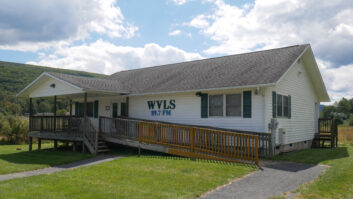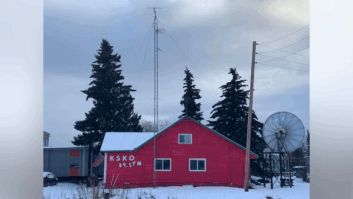The author is president of the American Association of Information Radio Operators.

With an increasing number of natural and manmade disasters in the daily news, U.S. public safety officials are embracing a ubiquitous and resilient medium to speak to citizens when all else fails. It won’t surprise Radio World readers that the medium is AM radio; what does surprise is that it is 10 watts and not 10,000 that are often employed.
The persistent question on the minds of our nation’s emergency managers is this: “When there is no longer grid power and when communication towers have gone horizontal, how will I speak to my citizens?”
Safety officials want a means of communication that can be their ace in the hole when third-party providers fail to deliver power and connectivity. And so, a legacy technology has stepped to the fore: humble 10-watt Travelers’ Information Stations.
WILDFIRES AND MORE
These stations can be licensed by a local or federal government entity on any open AM frequency on a secondary basis. The stations normally are found on 530 kHz or 1610–1700 kHz due to the scarcity of US broadcast stations on those channels.
TIS stations first appeared in national parks and airports in the 1980s, and later along the nation’s highways, as part of the Intelligent Transportation System buildout in the ’90s. More recently they have become a valuable asset for community safety. The stations commonly work as part of a system, in conjunction with a community’s outdoor warning sirens, NOAA/SAME (Specific Area Message Encoding) activations or IPAWS/EAS-based alerts.

Their value was bolstered recently when the FCC clarified that local officials have the authority to broadcast emergency information directly to citizens on TIS stations, also clarifying that determination of the content lies entirely with public safety officials in charge of incidents. The commission also relaxed bandwidth restrictions on the TIS service from 3000 to 5000 Hz. As a result, the growth in the number of TIS stations installed for community safety has increased.
Especially in the last decade, the stations have become recognized for their contributions in wildfire evacuation and recovery. When residents leave their homes and steer their automobiles toward evacuation lines, emergency managers use every mode of communication available to direct them. Many use TIS as part of that mix because it is totally under their control and is likely to stay active with loss of power, internet and third-party connectivity services.
When residents return to fire-ravaged communities, the stations can inform them regarding the plethora of safety and travel concerns they must be aware of as they reestablish their homes.
In the words of Mike Williams of California’s San Marcos Pass Volunteer Fire Department, “How do we advise motorists while fire lines are moving, given the uncertain state of cellular communications and the underlying desire to avoid promoting distracted driving? In Santa Barbara County, we have found success using this most old-school of technologies: AM radio.”
Williams has managed a TIS station in the county’s San Marcos Pass that has played role in multiple major wildland fire events and evacuations in the past decade.
There are many recent wildland fire events in which the TIS service has played a lifesaving role:
Idyllwild, Calif. — Cranston Fire, August 2018
“The reader must know that our entire mountain was without power for several days,” reported Bill Tell and Roland Gaebert of Idyllwild’s Mile High Amateur Radio Club. The situation took down many local broadcasters who didn’t have generators. “Temperatures were 90-plus, the internet was [often] not operational … nor were telephones fully functional.”
As the Cranston Fire raged mere miles away, forcing evacuations, Idyllwild’s TIS station WNKI578 on AM1610 remained fully operational 24/7. Tell and Gaebert kept the content current, utilizing links to the Fire Department and Riverside County EOC via HAM Radio/RACES.
Montecito, Calif. — Thomas Fire, December 2017
You will remember that Montecito was hard struck by the largest wildfire in California’s history, the Thomas Fire, which consumed 280,000 acres and, along with subsequent landslides, led to the largest loss of life and property in the area since the Great Santa Barbara earthquake of 1925.
The community already had an established multimodal communication system that included TIS radio technology. By utilizing these notification methods, including the Montecito Fire Protection District’s AM1610 TIS station, officials were able to reach citizens directly over the air while streaming the same programming via the Internet to computers and smartphones.
Jackie Jenkins, communications coordinator for the District’s fire department, said, “When all other critical infrastructure was lost intermittently due to strong power surges, we were able to rely on the AM radio [TIS station] to keep the community informed.”
Gatlinburg, Tenn. — Nov. 28, 2016
A world away in Tennessee, the popular tourist destination of Gatlinburg found itself in the path of an “inland hurricane of fire” that drove flames at 80 mph through the drought-parched Smoky Mountains and right into the city.

As the firestorm approached, officials began to evacuate 14,000 residents and visitors, but the speed and ferocity of the fire overwhelmed the power grid and their communication/911 systems. Water pumps burned and fire hydrants ran dry. Gone in one evening were entire neighborhoods and more than 2,500 buildings. Due to a superhuman effort by local safety officials, loss of life was limited to 14.
The city and Sevier County has now upgraded its warning systems to include 14 outdoor warning sirens and three synchronized TIS emergency advisory radio stations that can be used to guide citizens to recommended exit routes based on future fires’ locations and directions of travel. Motorists will be able to directly hear — on vehicle radios and in real time — advisories issued by safety officials on the ground, while reading the same messages in text form on computers and portable devices.
CONCLUSION
In so many instances, it is the local emergency managers, the fire officials, the broadcast engineers and the amateur radio operators who collaborate to make TIS radio stations function for communities that may find themselves suddenly in harm’s way. They only have 10 watts to work with, but, speaking on behalf of the members of AAIRO, I wish more power to them.
Learn about the American Association of Information Radio Operators at www.aairo.org. Comment on this or any story to [email protected].







